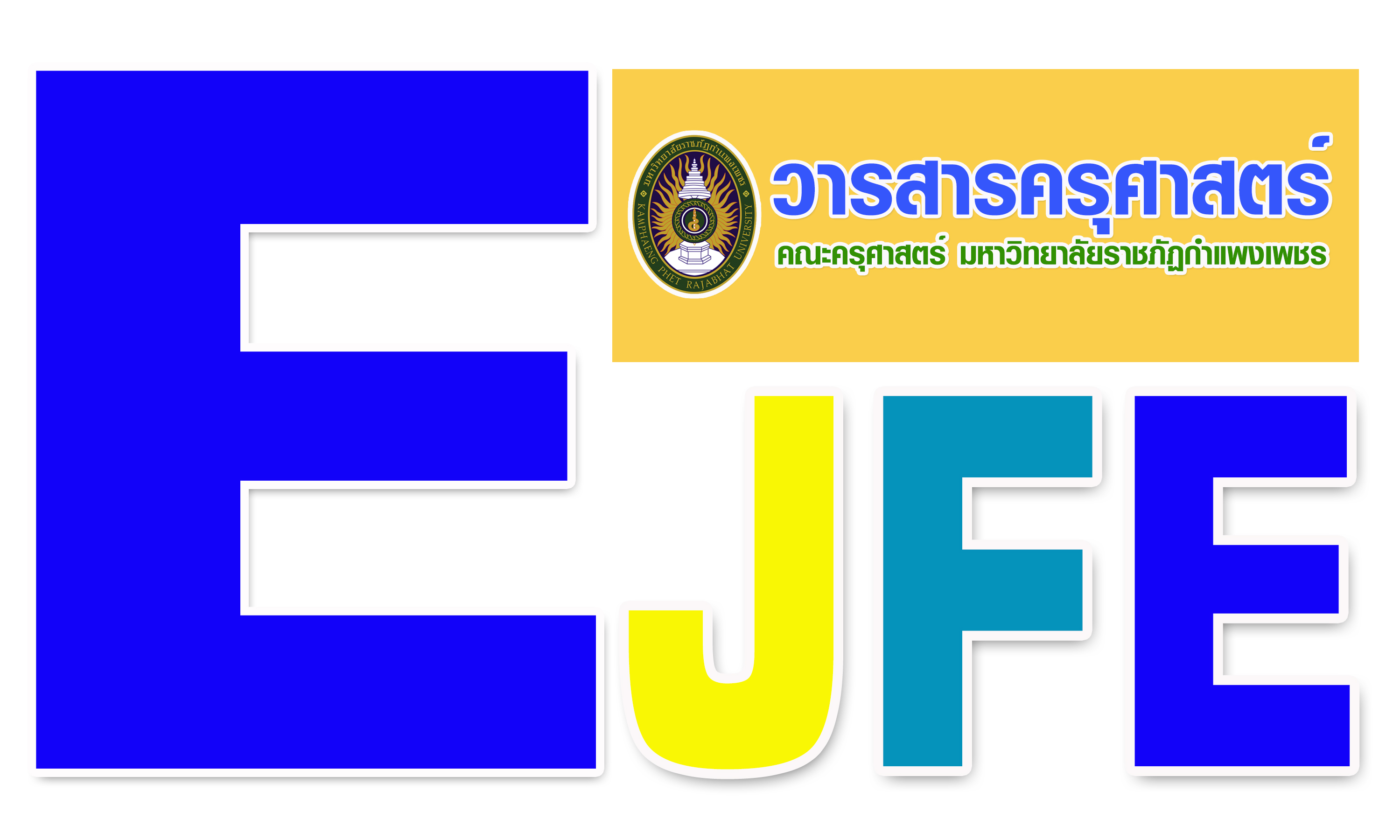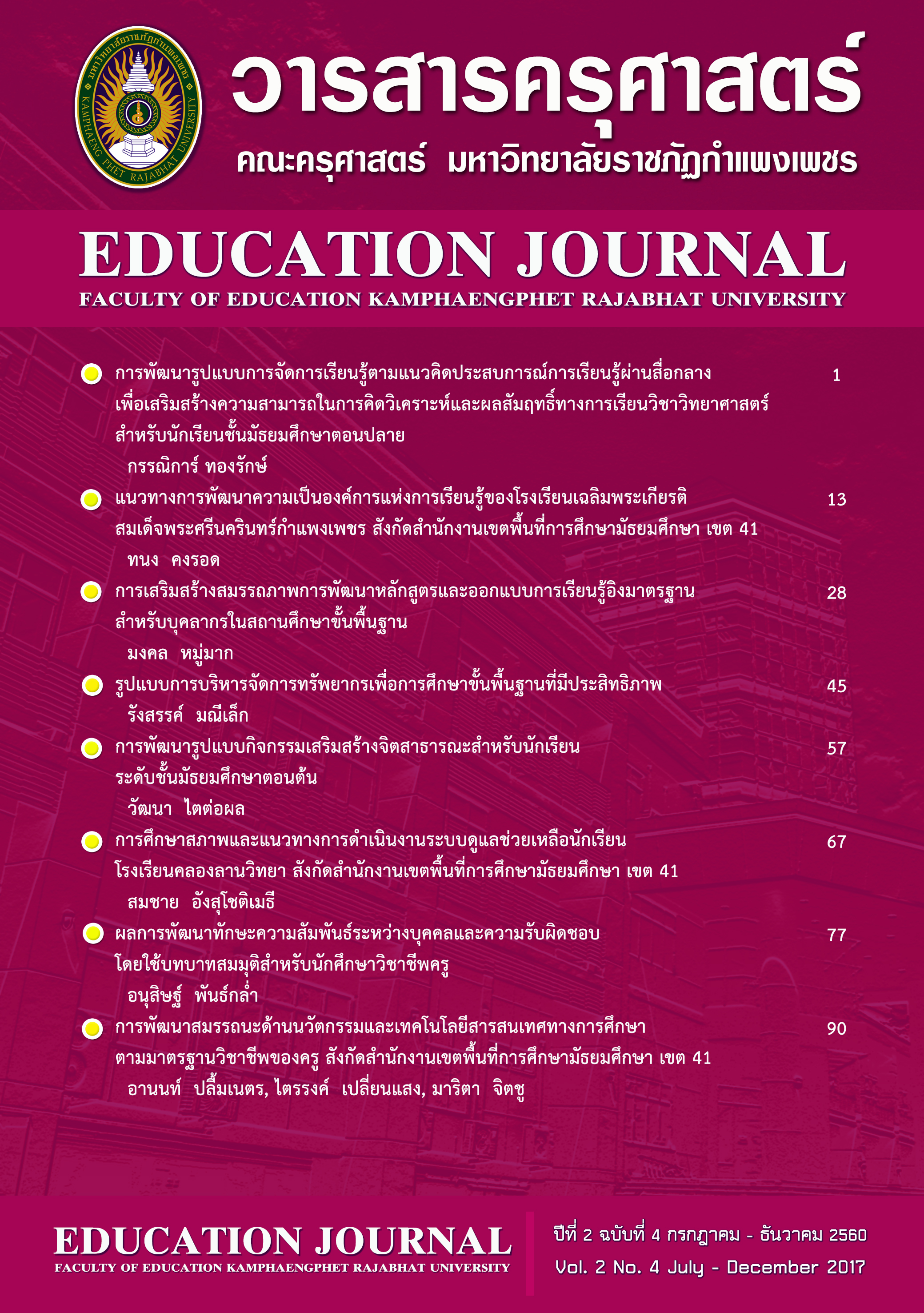การพัฒนารูปแบบกิจกรรมเสริมสร้างจิตสาธารณะสำหรับนักเรียน ระดับชั้นมัธยมศึกษาตอนต้น
Main Article Content
บทคัดย่อ
การวิจัยครั้งนี้มีวัตถุประสงค์ เพื่อสร้างและหาคุณภาพของรูปแบบกิจกรรมเสริมสร้างจิตสาธารณะ สำหรับนักเรียนระดับชั้นมัธยมศึกษาตอนต้น เปรียบเทียบคุณลักษณะจิตสาธารณะของนักเรียนระหว่างก่อนเรียนและหลังเรียน และศึกษาพฤติกรรมการมีจิตสาธารณะของนักเรียนหลังเรียน ด้วยกระบวนการวิจัยและพัฒนา 2 ขั้นตอน ขั้นที่ 1 สร้างและหาคุณภาพของ ขั้นที่ 2 ศึกษาผลการทดลองใช้ กลุ่มประชากร ได้แก่ นักเรียนชั้นมัธยมศึกษาปีที่ 1 ปีการศึกษา 2557 จำนวน 499 คน กลุ่มตัวอย่าง ได้แก่ นักเรียนชั้นมัธยมศึกษาปีที่ 1 โดยการสุ่มนักเรียนแบบแบ่งกลุ่ม จำนวน 1 ห้อง จำนวน 40 คน เครื่องมือที่ใช้ในการวิจัย ได้แก่ รูปแบบกิจกรรมเสริมสร้างจิตสาธารณะ สำหรับนักเรียนระดับชั้นมัธยมศึกษาตอนต้น แบบวัดจิตสาธารณะ และแบบประเมินพฤติกรรมการมีจิตสาธารณะ สถิติที่ใช้ในการวิจัย ได้แก่ ค่าร้อยละค่าเฉลี่ย ส่วนเบี่ยงเบนมาตรฐาน และการทดสอบค่าที ผลการวิจัยพบว่า การสร้างและหาคุณภาพของรูปแบบกิจกรรมเสริมสร้างจิตสาธารณะ สำหรับนักเรียนระดับชั้นมัธยมศึกษาตอนต้น มีความเหมาะสมอยู่ในระดับมากที่สุด และการนำรูปแบบไปทดลองนำร่อง พบว่า มีความเหมาะสมและเป็นไปได้ในทางปฏิบัติ และการทดลองใช้รูปแบบ พบว่า นักเรียนมีคุณลักษณะจิตสาธารณะทุกด้านโดยรวมหลังการเรียนสูงกว่าก่อนเรียน อย่างมีนัยสำคัญทางสถิติที่ระดับ .05 และนักเรียนมีพฤติกรรม การมีจิตสาธารณะหลังเรียนในภาพรวม อยู่ในระดับ ดีเยี่ยม
Article Details

อนุญาตภายใต้เงื่อนไข Creative Commons Attribution-NonCommercial 4.0 International License.
CC Attribution-NonCommercial-NoDerivatives 4.0
เอกสารอ้างอิง
เกียรติศักดิ์ แสงอรุณ. (2553). แนวทางการพัฒนาจิตสำนึกสาธารณะสำหรับเยาวชนไทย : กรณีศึกษากลุ่มและเครือข่ายเยาวชนที่ทำงานด้านจิตสำนึกสาธารณะ. วิทยานิพนธ์ครุศาสตรมหาบัณฑิต สาขาวิชาพัฒนศึกษา คณะครุศาสตร์ จุฬาลงกรณ์มหาวิทยาลัย.
ชวาลา เวชยันต์. (2544). การพัฒนาแบบการเรียนการสอนที่ใช้เทคนิคการเรียนรู้ด้วยการรับใช้สังคมเพื่อส่งเสริมความตระหนักในการรับใช้สังคม ทักษะการแก้ปัญหาและผลสัมฤทธิ์ทางการเรียนของนักเรียนชั้นมัธยมศึกษาปีที่ 1. วิทยานิพนธ์ กศ.ด (หลักสูตรและการสอน). กรุงเทพฯ. จุฬาลงกรณ์มหาวิทยาลัย.
ทิศนา แขมมณี. (2552). ศาสตร์การสอน : องค์ความรู้เพื่อการจัดกระบวนการเรียนรู้ที่มีประสิทธิภาพ. กรุงเทพฯ : สำนักพิมพ์แห่งจุฬาลงกรณ์มหาวิทยาลัย.
ลัดดาวัลย์ เกษมเนตร และคณะ. (2547). รูปแบบการพัฒนานักเรียนระดับประถมศึกษาให้มีจิตสาธารณะ : การศึกษาระยะยาว. ใน เอกสารประกอบการประชุมวิชาการเนื่องในวันสถาปนาสถาบันวิจัยพฤติกรรมศาสตร์ครบรอบ 49 ปี. หน้า 1 – 3. กรุงเทพฯ : มหาวิทยาลัยศรีนครินทรวิโรฒ.
ศักดิ์ชัย นิรัญทวี และคณะ. (2544). รายงานการวิจัย เรื่อง การเรียนรู้ด้วยการรับใช้สังคม. กรุงเทพฯ : สำนักงานคณะกรรมการการศึกษาแห่งชาติ สำนักนายกรัฐมนตรี.
สมพงษ์ จิตระดับ. (2554). หัวข้อเสวนา “ ทิศทางเด็กพันธ์อาร์รองรับตลาดอาเซียน 58” ในงานแถลงข่าวประกาศสนับสนุนโครงการส่งเสริมนวัตกรรมสร้างสรรค์การเรียนรู้ระดับอาชีวศึกษา ครั้งที่ 1/2554 : สำนักงานส่งเสริมสังคมแห่งการเรียนรู้ และคุณภาพเยาวชน (สสค.) และ สำนักงานคณะกรรมการการอาชีวศึกษา, 8 มิถุนายน 2554.
สุริยเดว ทรีปาตี. (2552). ปัจจัยเสี่ยงและปัจจัยป้องกันหรือส่งเสริมสุขภาพวัยรุ่น. สืบค้นเมื่อ 20 ธันวาคม 2552, จาก http://www.wearehappy.in.th/happykids/happykidsteen/สำนักงานคณะกรรมการการศึกษาแห่งชาติ. (2545). แผนการศึกษาแห่งชาติ (๒๕๔๕-๒๕๕๙). กรุงเทพฯ : พริกหวานกราฟฟิค จำกัด.
Bandura, A (1997). Social learning theory. Englewood Cliffs, NJ : Prentice-Hall.
Giles, D. E., & Eyler, J. S. (1998). Service-learning and the development of expertCitizens : Service-learning and cognitive science. In R. G. Bringle & D. K.
Joyce, B. R. and Weil, E.A. (2004). Models of teaching (7th ed.). London : Allyn&Bacon.


